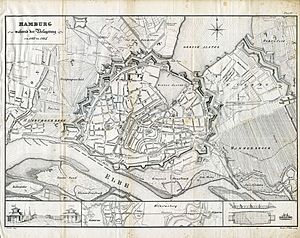Siege of Hamburg facts for kids
Quick facts for kids Siege of Hamburg |
|||||||
|---|---|---|---|---|---|---|---|
| Part of the War of the Sixth Coalition | |||||||
 1830s map of Hamburg during the siege (1813–14) |
|||||||
|
|||||||
| Belligerents | |||||||
| Commanders and leaders | |||||||
| Strength | |||||||
| 40,000 initially (25,000 men later left for France) |
56,000 | ||||||
| Casualties and losses | |||||||
| 6,000 killed or wounded | 6,000 killed or wounded | ||||||
The Siege of Hamburg was a long military event that took place in the city of Hamburg between December 1813 and May 1814. It was part of the larger War of the Sixth Coalition, where many European countries fought against Napoleon Bonaparte's French Empire. Hamburg was a very important city because it was a strong fortress located east of the Rhine River.
At first, Hamburg was freed from French control by Cossacks and other Allied troops. However, on May 28, 1813, French forces led by Marshal Davout took the city back. Davout was ordered to hold Hamburg no matter what. He launched strong attacks against the Allied forces, which included soldiers from Prussia. These Allied troops were led by Count von Wallmoden-Gimborn.
Fighting Around Hamburg
Both sides had similar numbers of soldiers, so neither side could win easily. The fighting became a stalemate, meaning neither side could make much progress. The front line, or battle line, stayed mostly the same between the cities of Lübeck and Lauenburg, and along the Elbe River. This continued even after a ceasefire ended in the summer of 1813.
In October 1813, French troops moved towards Dannenberg. This led to the only major battle in northern Germany during this time, called the Battle of the Göhrde. The French lost this battle and had to retreat back to Hamburg.
The Siege Continues
Even though Marshal Davout's French forces in Hamburg were running low on soldiers, food, and ammunition, they did not give up. After Napoleon's army lost the important Battle of Leipzig at the end of 1813, French armies began to retreat west. The Allied forces then sent a large part of their army, led by Bernadotte, to keep watch over Hamburg.
Davout remained in control of Hamburg even after the War of the Sixth Coalition officially ended in April 1814. He finally surrendered to Russian forces, led by General Bennigsen, on May 27, 1814. He only gave up after receiving orders from the new king of France, Louis XVIII.
Military Strength During the Siege
- French Forces: At the start, there were about 42,000 French soldiers. This number included 10,000 Danish soldiers and 8,000 wounded soldiers.
- Allied Forces: The Allied army started with about 52,000 soldiers under Count von Wallmoden-Gimborn. By January 1814, when General Bennigsen took command, the Allied forces in the area grew to about 120,000 soldiers.
See also

